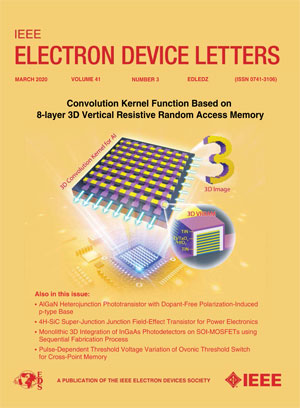Role of Oxygen Deficiencies on the Stability of Indium Tin Oxide (ITO) Transistors
IF 4.5
2区 工程技术
Q2 ENGINEERING, ELECTRICAL & ELECTRONIC
引用次数: 0
Abstract
We investigate the threshold voltage (缺氧对氧化铟锡(ITO)晶体管稳定性的影响
我们研究了氧化铟锡(ITO)晶体管在正栅偏置应力下的阈值电压(${V}_{T}$)稳定性,并比较了$\text{Al}_{\mathbf {{2}}}\text {O}_{\mathbf {{3}}}$和$\text{HfO}_{\mathbf {{2}}}$电介质的性能。我们将顶门控装置不寻常的负${V} _{\mathbf {T}}$位移($\Delta {V}_{T} \lt 0$ V)归因于电介质对氧气的清除。值得注意的是,介电层为$\text{Al}_{\mathbf {{2}}}\text {O}_{\mathbf {{3}}}$的器件在室温下的中位数mV为$\vert \Delta {V}_{T}\vert \le 10$,比介电层为$\text{HfO}_{\mathbf {{2}}}$的器件低$\sim 10\times $,突出了介电层的显著影响。我们还证明,在高温(85°C)下,双门控晶体管的顶部和底部栅极的相反效应可用于在2 V栅极应力电压下获得中位数$\vert \Delta {V}_{T}\vert \approx ~150$ mV,这比相同应力条件下的顶部门控器件低$\sim 3\times $。
本文章由计算机程序翻译,如有差异,请以英文原文为准。
求助全文
约1分钟内获得全文
求助全文
来源期刊

IEEE Electron Device Letters
工程技术-工程:电子与电气
CiteScore
8.20
自引率
10.20%
发文量
551
审稿时长
1.4 months
期刊介绍:
IEEE Electron Device Letters publishes original and significant contributions relating to the theory, modeling, design, performance and reliability of electron and ion integrated circuit devices and interconnects, involving insulators, metals, organic materials, micro-plasmas, semiconductors, quantum-effect structures, vacuum devices, and emerging materials with applications in bioelectronics, biomedical electronics, computation, communications, displays, microelectromechanics, imaging, micro-actuators, nanoelectronics, optoelectronics, photovoltaics, power ICs and micro-sensors.
 求助内容:
求助内容: 应助结果提醒方式:
应助结果提醒方式:


